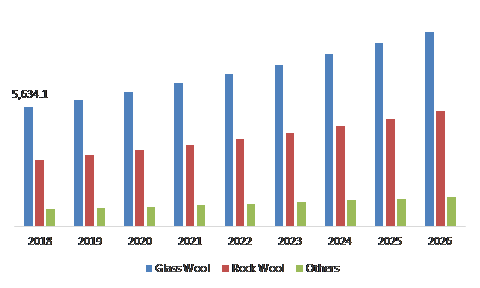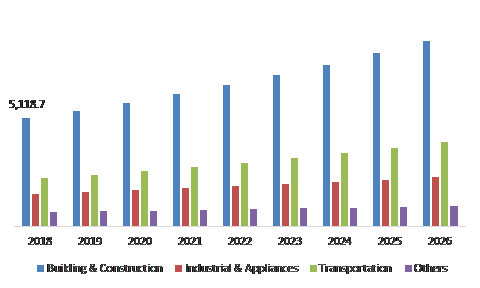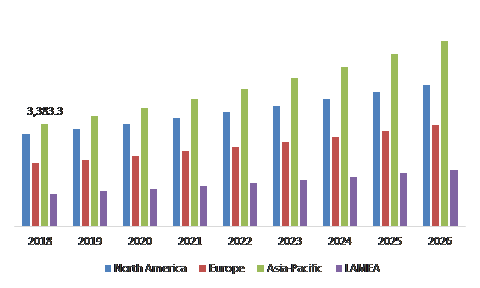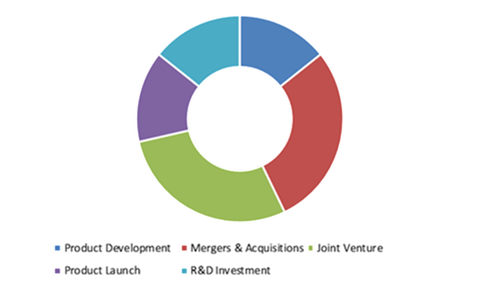Mineral Wool Market Report
RA00068
Mineral Wool Market by Type (Glass Wool, Rock Wool and Others) by End use (Building & Construction, Industrial & Appliances, Transportation and Others) Regional Outlook (North America, Europe, Asia-Pacific, LAMEA), Global Opportunity Analysis and Industry Forecast, 2019–2026
Update Available On-Demand
Global Mineral Wool Market Research Report Overview 2026:
The mineral wool market size was $9,614.5 million in 2018 and is predicted to grow at a CAGR of 6.6% by generating a revenue of $16,031.8 million by 2026. Asia-pacific market was $3,383.3 million in 2018 and is predicted to grow at a CAGR of 7.7% in during forecast period.
Mineral wool are the fibers which are made from the synthetic materials. Mineral wools are easy to install, safe, fireproof and use recycled material to manufacture. Mineral wool is made from industrial waste (slag), stone or molten glass by melting the raw material at a very high temperature and spinning it to produce a very thin fiber. The resulting material is further coated so that the material holds itself together. The product can then be rolled or flattened into a film, depending on the need. The demand for the mineral wool are mainly driven by the industrial application where mineral wools are used as an insulation.
Mineral Wool Market Synopsis
The market for mineral wool is primarily driven by product development and the rapidly growing construction industry across the globe.
The main restraining factor of the mineral wool market is the lack of skilled workforce for applying mineral wool to the surface as it has adverse effects on the human health.
According to the regional analysis of the market, the Asia-Pacific mineral wool market is anticipated to grow at a CAGR of 7.7%, by generating a revenue of $3,383.3 million during the review period.
Market Drivers and Restrains:
Increase in construction of the residential and commercial buildings is predicted to be the major mineral wool market drivers.
Mineral wool is mostly used as the insulator, and is considered to be one of the best insulators as compared to others. Due to availability of the raw material, ease of installation, durability and recycle property Mineral wool is being used by most of the construction companies as an insulator for construction of house or office premises. It has the feasibility of fire resistance, noise reduction and provides thermal protection. It also helps in preventing the air flow due to climatic change which maintains moderate temperature in the area. With the rise in the construction industry the demand for mineral wool is predicted to increase over the coming years.
Lack of skilled workforce for applying mineral wool to the surface is considered to be the biggest restrains for the market
Lack of skilled workforce for the application of mineral wool to the surface is considered to be the major restraint for the mineral wool material market. One may find easy to install the mineral wool into the surface but it’s the most dangerous thing which causes adverse effect on the health of the person. While applying the mineral wool the tiny particles may stick to the skin of the worker and cause serious skin disease. Moreover, if it is inhaled, it can have adverse effects on the lungs, which can be a serious threat to the handlers. Due to these reasons the workers are not interested in handling mineral wool. This is the biggest restraint for the rockwool market.
Mineral wool market, by type:
Glass wool is the most effective and most profitable type in mineral wool market.

Source: Research Dive Analysis
Glass wool is expected to have the largest mineral wool market share of 58% in 2018. This segment generated a revenue of $5,634.1 million in 2018 and is predicted to grow at a CAGR of 6.3% during the forecast period. The glass wool is the majorly used insulation material due to its easy installation, fire proof property and low prices. It also acts like an excellent sound barrier which doesn’t allow the sound coming from outside and also limit the transfer of heat & cold and keeps room temperature normal. Glass wool are easy to clean and are comparatively strong and durable. Due to these factors, it is expected to drive the mineral wool market in the forecast period.
Mineral wool market, by end use:
Building and construction is predicted to have the highest mineral wool market growth in the forecast period.

Source: Research Dive Analysis
Mineral wool market forecast that building and construction segment is considered to have the highest growth rate in the forecast period. This segment is predicted to grow at a CAGR of 6.9% by generating a revenue of $8,737.3 million by 2026. Due to the increase in urbanization, change in the social trends, and rising consumer spending on renewable construction will significantly enhance the use of mineral wool in the building & construction sector. In addition, it has proven to be the most cost effective insulator for the use in the building and construction.
Mineral wool market, by Asia-Pacific Region:
Asia-Pacific can create an opportunity for the investors in the mineral wool market in the forecast period

Source: Research Dive Analysis
Asia-Pacific accounted for the largest market share of over 35% in 2018. Asia-pacific market was $3,383.3 in 2018 and is predicted to grow at a CAGR of 7.7% in the forecast period. Asia pacific with its emerging economy and increase in the construction sector and rise in the industrial base is projected to drive the mineral wool market. In addition, government initiatives in renovating the existing building is anticipated to accelerate the region for mineral wool market.
Key participants in Mineral wool market:

Source: Research Dive Analysis
Mineral Wool Market players are Owens Corning India Ltd., Maghard Insulators, Rockwool International, Saint-Gobain, Knauf Insulation, Thermafiber, Inc., USG Interiors Inc, Johns Manville, Roxul Inc., and CertainTeed Corp among others.
Report Scope:
| Aspect | Particulars |
| Historical Market Estimations | 2018-2019 |
| Base Year for Market Estimation | 2018 |
| Forecast timeline for Market Projection | 2019-2026 |
| Geographical Scope | North America, Europe, Asia-Pacific, LAMEA |
| Segmentation by Type |
|
| Segmentation by End Use |
|
| Key Countries Covered | U.S., Canada, Germany, France, UK, Italy, Japan, China, India, South Korea, Australia, Middle west, Africa |
| Key Companies Profiled |
|
Source: Research Dive Analysis
Q1. What is the size of Mineral wool market?
A. The global mineral wool market size was over $9,614.5 million in 2018, and is further anticipated to reach $16,031.8 million by 2026.
Q2. Which are the leading companies in the Mineral wool market?
A. Thermafiber Inc. and USG Interiors Inc Corporation are some of the key players in the global Mineral wool market.
Q3. Which region possesses greater investment opportunities in the coming future?
A. Asia Pacific possesses great investment opportunities for the investors to witness the most promising growth in the coming years.
Q4. What is the growth rate of Asia-Pacific?
A. Asia-Pacific Mineral wool market is projected to grow at 7.7% CAGR during the forecast period.
Q5. What are the strategies opted by the leading players in this market?
A. Product development are the key strategies opted by the operating companies in this market.
Q6. Which companies are investing more on R&D practices?
A. Thermafiber Inc. and USG Interiors Inc are the companies investing more on R&D activities for developing new products and technologies.
1. Research Methodology
1.1. Desk Research
1.2. Real time insights and validation
1.3. Forecast model
1.4. Assumptions and forecast parameters
1.4.1. Assumptions
1.4.2. Forecast parameters
1.5. Data sources
1.5.1. Primary
1.5.2. Secondary
2. Executive Summary
2.1. 360° summary
2.2. Type trends
2.3. End use trends
3. Market overview
3.1. Market segmentation & definitions
3.2. Key takeaways
3.2.1. Top investment pockets
3.2.2. Top winning strategies
3.3. Porter’s five forces analysis
3.3.1. Bargaining power of consumers
3.3.2. Bargaining power of suppliers
3.3.3. Threat of new entrants
3.3.4. Threat of substitutes
3.3.5. Competitive rivalry in the market
3.4. Market dynamics
3.4.1. Drivers
3.4.2. Restraints
3.4.3. Opportunities
3.5. Technology landscape
3.6. Regulatory landscape
3.7. Patent landscape
3.8. Pricing overview
3.8.1. By type
3.8.2. By end use
3.8.3. By region
3.9. Market value chain analysis
3.9.1. Stress point analysis
3.9.2. Raw material analysis
3.9.3. Manufacturing process
3.9.4. Distribution channel analysis
3.9.5. Operating vendors
3.9.5.1. Raw material suppliers
3.9.5.2. Product manufacturers
3.9.5.3. Product distributors
3.10. Strategic overview
4. Mineral wool market, by Type
4.1. Glass Wool
4.1.1. Market size and forecast, by region, 2017-2028
4.1.2. Comparative market share analysis, 2018 & 2028
4.2. Rock Wool
4.2.1. Market size and forecast, by region, 2017-2028
4.2.2. Comparative market share analysis, 2018 & 2028
4.3. Others
4.3.1. Market size and forecast, by region, 2017-2028
4.3.2. Comparative market share analysis, 2018 & 2028
5. Mineral wool market, by End use
5.1. Building & Construction
5.1.1. Market size and forecast, by region, 2017-2028
5.1.2. Comparative market share analysis, 2018 & 2028
5.2. Industrial & Appliances
5.2.1. Market size and forecast, by region, 2017-2028
5.2.2. Comparative market share analysis, 2018 & 2028
5.3. Transportation
5.3.1. Market size and forecast, by region, 2017-2028
5.3.2. Comparative market share analysis, 2018 & 2028
5.4. Others
5.4.1. Market size and forecast, by region, 2017-2028
5.4.2. Comparative market share analysis, 2018 & 2028
6. Mineral wool market, by Region
6.1. North Region
6.1.1. Market size and forecast, by type, 2017-2028
6.1.2. Market size and forecast, by end-use, 2017-2028
6.1.3. Market size and forecast, by country, 2017-2028
6.1.4. Comparative market share analysis, 2018 & 2028
6.1.5. U.S
6.1.5.1. Market size and forecast, by type, 2017-2028
6.1.5.2. Market size and forecast, by end-use, 2017-2028
6.1.5.3. Comparative market share analysis, 2018 & 2028
6.1.6. Canada
6.1.6.1. Market size and forecast, by type, 2017-2028
6.1.6.2. Market size and forecast, by end-use, 2017-2028
6.1.6.3. Comparative market share analysis, 2018 & 2028
6.2. Europe
6.2.1. Market size and forecast, by type, 2017-2028
6.2.2. Market size and forecast, by end-use, 2017-2028
6.2.3. Market size and forecast, by country, 2017-2028
6.2.4. Comparative market share analysis, 2018 & 2028
6.2.5. Germany
6.2.5.1. Market size and forecast, by type, 2017-2028
6.2.5.2. Market size and forecast, by end-use, 2017-2028
6.2.5.3. Comparative market share analysis, 2018 & 2028
6.2.6. France
6.2.6.1. Market size and forecast, by type, 2017-2028
6.2.6.2. Market size and forecast, by end-use, 2017-2028
6.2.6.3. Comparative market share analysis, 2018 & 2028
6.2.7. Rest of Europe
6.2.7.1. Market size and forecast, by type, 2017-2028
6.2.7.2. Market size and forecast, by end-use, 2017-2028
6.2.7.3. Comparative market share analysis, 2018 & 2028
6.3. Asia-Pacific
6.3.1. Market size and forecast, by type, 2017-2028
6.3.2. Market size and forecast, by end-use, 2017-2028
6.3.3. Market size and forecast, by country, 2017-2028
6.3.4. Comparative market share analysis, 2018 & 2028
6.3.5. China
6.3.5.1. Market size and forecast, by type, 2017-2028
6.3.5.2. Market size and forecast, by end-use, 2017-2028
6.3.5.3. Comparative market share analysis, 2018 & 2028
6.3.6. India
6.3.6.1. Market size and forecast, by type, 2017-2028
6.3.6.2. Market size and forecast, by end-use, 2017-2028
6.3.6.3. Comparative market share analysis, 2018 & 2028
6.3.7. Japan
6.3.7.1. Market size and forecast, by type, 2017-2028
6.3.7.2. Market size and forecast, by end-use, 2017-2028
6.3.7.3. Comparative market share analysis, 2018 & 2028
6.3.8. South Korea
6.3.8.1. Market size and forecast, by type, 2017-2028
6.3.8.2. Market size and forecast, by end-use, 2017-2028
6.3.8.3. Comparative market share analysis, 2018 & 2028
6.3.9. Australia
6.3.9.1. Market size and forecast, by type, 2017-2028
6.3.9.2. Market size and forecast, by end-use, 2017-2028
6.3.9.3. Comparative market share analysis, 2018 & 2028
6.3.10. Rest of Asia-Pacific
6.3.10.1. Market size and forecast, by type, 2017-2028
6.3.10.2. Market size and forecast, by end-use, 2017-2028
6.3.10.3. Comparative market share analysis, 2018 & 2028
6.4. LAMEA
6.4.1. Market size and forecast, by type, 2017-2028
6.4.2. Market size and forecast, by end-use, 2017-2028
6.4.3. Market size and forecast, by country, 2017-2028
6.4.4. Comparative market share analysis, 2018 & 2028
6.4.5. Middle west
6.4.5.1. Market size and forecast, by type, 2017-2028
6.4.5.2. Market size and forecast, by end-use, 2017-2028
6.4.5.3. Comparative market share analysis, 2018 & 2028
6.4.6. Africa
6.4.6.1. Market size and forecast, by type, 2017-2028
6.4.6.2. Market size and forecast, by end-use, 2017-2028
6.4.6.3. Comparative market share analysis, 2018 & 2028
7. Company profiles
7.1. Owens Corning, India Ltd.
7.1.1. Business overview
7.1.2. Financial performance
7.1.3. Product portfolio
7.1.4. Recent strategic moves & developments
7.1.5. SWOT analysis
7.2. Maghard Insulators
7.2.1. Business overview
7.2.2. Financial performance
7.2.3. Product portfolio
7.2.4. Recent strategic moves & developments
7.2.5. SWOT analysis
7.3. ROCKWOOL International A/S
7.3.1. Business overview
7.3.2. Financial performance
7.3.3. Product portfolio
7.3.4. Recent strategic moves & developments
7.3.5. SWOT analysis
7.4. Saint-Gobain
7.4.1. Business overview
7.4.2. Financial performance
7.4.3. Product portfolio
7.4.4. Recent strategic moves & developments
7.4.5. SWOT analysis
7.5. Knauf Insulation
7.5.1. Business overview
7.5.2. Financial performance
7.5.3. Product portfolio
7.5.4. Recent strategic moves & developments
7.5.5. SWOT analysis
7.6. Thermafiber, Inc.
7.6.1. Business overview
7.6.2. Financial performance
7.6.3. Product portfolio
7.6.4. Recent strategic moves & developments
7.6.5. SWOT analysis
7.7. USG Interiors Inc.
7.7.1. Business overview
7.7.2. Financial performance
7.7.3. Product portfolio
7.7.4. Recent strategic moves & developments
7.7.5. SWOT analysis
7.8. Johns Manville
7.8.1. Business overview
7.8.2. Financial performance
7.8.3. Product portfolio
7.8.4. Recent strategic moves & developments
7.8.5. SWOT analysis
7.9. Roxul Inc.
7.9.1. Business overview
7.9.2. Financial performance
7.9.3. Product portfolio
7.9.4. Recent strategic moves & developments
7.9.5. SWOT analysis
7.10. CertainTeed Corp
7.10.1. Business overview
7.10.2. Financial performance
7.10.3. Product portfolio
7.10.4. Recent strategic moves & developments
7.10.5. SWOT analysis
Mineral wool is an in-organic, non-metallic product manufactured from a carefully measured mix of raw materials. These raw materials mainly comprise of silica or stone, which are heated to a high temperature until they are melted. The molten stone or glass is then rolled and formed into a fibrous, flexible mat for further processing into the needed finished products.
The excellent acoustic, fire, and thermal properties of mineral wool originate from the mat of fibers. This mat of fiber forms the inert chemical composition of mineral wool by preventing the movement of air. Mineral wool is thus a very versatile material that can be manufactured to numerous different densities such as in different shapes, varied properties, and a variety of sheet materials.
Acoustic Strengths of Mineral Wool Insulation
Noise pollution or unwanted sound inhibits privacy, and increases agitation that can be bad for health. The range of noise can vary from being a distracting irritation to resulting into loss of hearing, which is actual physical damage. Be it home or workplace, there are millions of people in the world who suffer from the effects of exposure to noise above 65 decibels. Also, the treatment cost for health problems directly related to noise turns into many millions of dollars annually.
Due to the structure of mineral wool insulation, it provides a highly effective barrier to noise. The global mineral wool market has developed a wide range of mineral wool products that helps in better management of sound, including wall linings, acoustic ceiling tiles, roof/floor sound installation, partition cavity filings, and absorption solutions. These products are used in all kinds of settings from homes, public buildings, offices, and also in industrial facilities, laboratories, and hospitals.
Industrial Applications of Mineral Wool
There are a widespread variety of applications within the mineral wool industry from lagging pipes, enhancing air-conditioning systems, to high performance insulation products for shipping. The leading manufacturers are constantly initiating research and development activities to create products, which are tailored to environment and specific uses. For instance, technical insulation products have been developed to function in standard conditions even at 900°C - such as for power smoke flues, point boilers, and industrial piping. The benefits include improved safety for workers, reduced energy expenditure, and reduced condensation problems.
Mineral wool insulation is a key part of marine life. One of the most significant reason to insulate onboard is to save lives in case of fire. However, mineral wool’s outstanding acoustic and thermal insulating capacity is also essential in providing enjoyable environment for passengers and good working conditions for the staff. Although, the insulation work is challenging in a shipyard, and hence, a wide range of preformed and pre-covered insulation products are available, which deliver weight savings, cost, and labor.
Coming back on the land, the insulation of mineral wool is also used for air conditioning systems, ventilation, and heating in industrial as well as commercial buildings. Thus, the mineral wool can be used to keep the heating water hot and the cooling water cold to avoid condensation.
Potential Future of Mineral Wool Market
Global market for mineral wool is anticipated to witness a significant growth from 2019 to 2026. Abundant availability of resources, efficiency in material transportation, low carbon footprint, ease for installation, reduction in air pollution, combats noise pollution, safety, energy efficient insulation, recyclable properties, and durability are the factors that are driving the growth of global mineral wool market.
Mineral wool is easy to install but it harms the health conditions of the worker. The precautions to be taken while mineral wool installation and the availability of alternative cheap insulating materials are some of the challenges that will further hamper the growth of mineral wool market globally. The governments in both developed and developing countries is taking initiatives towards inaction of several climate policy promises owing to the growth in population, environmental changes, and urbanization. Customers are focusing on reducing the bill amounts for energy consumption with retrofitting the mineral wool product on ceilings, attics, and walls. The industry participants will have enormous opportunities in the mineral wool market as the trend is shifting towards upgradation of existing insulation system.
Rising demand for mineral wool in the buildings & construction industry for residential and commercial infrastructures is giving significant boost to the growth of global mineral wool market in the upcoming years. As per the statistics provided by a Research Dive report, the global market for mineral wool is anticipated to grow at rise at a 6.6% CAGR, and will surpass $16,031.8 million by the end of 2026. The report highlights the major players operating in the global market. Some of them are CertainTeed Corp, USG Interiors Inc., Roxul Inc, Knauf Insulation, Thermafiber Inc., Saint-Gobain, ROCKWOOL International A/S, Johns Manville, Maghard Insulator, Owens Corning, India Ltd., and others. These players are adopting several strategies such as mergers & acquisitions, strategic partnerships, R&D investments, and collaboration to enhance their presence in the global market.
Personalize this research
- Triangulate with your own data
- Request your format and definition
- Get a deeper dive on a specific application, geography, customer or competitor
- + 1-888-961-4454 Toll - Free
- support@researchdive.com

